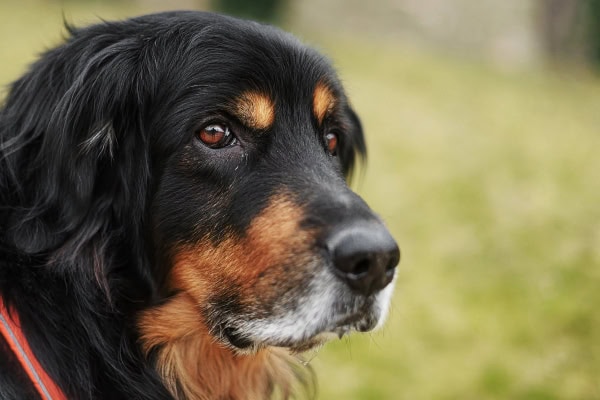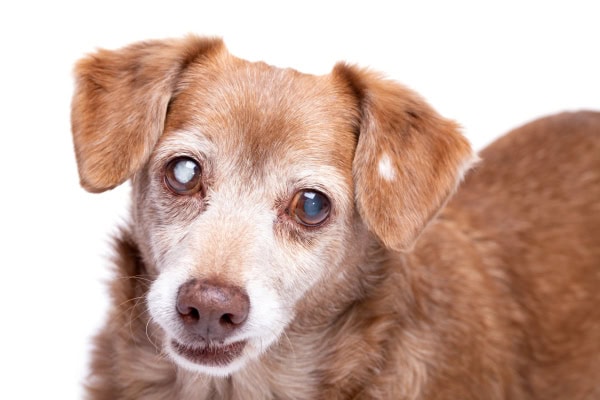If your senior dog starts to pant, pace, bark, or become agitated or destructive when you leave your home (or just leave the room), separation anxiety in older dogs could be the culprit. Integrative veterinarian Dr. Julie Buzby explains why older dogs might develop separation anxiety and how to recognize it. Plus she provides nine tips for decreasing your senior dog’s separation anxiety.

Dog parents may associate separation anxiety with puppies or recently adopted adult dogs. However, any dog, at any age, can develop separation anxiety—including senior dogs. Thus, it is important for parents of older dogs to understand triggers and signs of separation anxiety and how to address it.
What is separation anxiety in dogs?
Separation anxiety is a behavioral disorder in which dogs become uncomfortable and distressed when a person or another animal they are bonded with leaves the house or prepares to leave. It can also be triggered by someone leaving the room—even if the dog can go join them.
Dogs with separation anxiety experience a range of emotional and physical responses when left alone. Some of the more common ones include excessive barking or whining, destructive behaviors, house soiling, and even attempts to escape. The severity of the reaction can vary from dog to dog and situation to situation.
Symptoms of separation anxiety can develop early in life during puppyhood, but they also can appear later in life. And separation anxiety can be particularly concerning for older dogs.
Why do older dogs develop separation anxiety?
If your senior dog previously didn’t mind when you left the home, but is now experiencing separation anxiety, there is a good chance something else is going on with your dog too. Some specific reasons why older dogs may suddenly develop separation anxiety include:
Becoming deaf or blind
Dogs who lose their hearing or vision can sometimes develop separation anxiety, particularly in the beginning. Without their ability to see and/or hear, they may rely more on their pet parents for reassurance and guidance.
Additionally, deaf or blind dogs may not notice when someone leaves the room or the home. The sudden realization that their person is no longer there can cause added stress and anxiety.

Developing a new medical condition
Senior dog separation anxiety can also arise with certain medical conditions. Just like people find comfort in their dogs when they’re feeling unwell, many sick or injured dogs feel more at ease when their owners are nearby.
If your dog has recently developed a medical issue causing discomfort, he or she may experience separation anxiety as a result. For some dogs, the anxiety may subside once the dog starts feeling better. However, for other dogs who have developed separation anxiety alongside an illness, the anxiety may be an ongoing issue.
Showing signs of canine cognitive dysfunction
In older dogs who are not deaf, blind, or experiencing another medical condition, canine cognitive dysfunction (CCD) or doggy dementia is the main reason for sudden onset separation anxiety. Signs of dementia in dogs include changes in a dog’s behavior such as having accidents in the house, forgetting basic commands, the dog walking in circles, changes in sleep/wake cycles, and interacting differently with family members and other pets.
Because dogs with CCD can become easily confused, disoriented, or lost, they often become anxious too. This might be generalized anxiety, separation anxiety, noise anxiety, or a combination of anxiety types.
What are the symptoms of separation anxiety in older dogs?
Older dogs with separation anxiety often have very similar symptoms to those seen in younger dogs. Typically, senior dogs may exhibit the following signs to varying degrees:
- Appearing startled or worried when you walk out of the room
- Frantically searching for you if you leave the room and your dog does not notice right away
- Following you around the home more than previously
- Appearing worried when you begin getting ready to leave
- Pacing, panting, trembling, or drooling that may start even before you actually leave
- Excessive vocalization (barking, howling, or whining) when alone
- Destructive behavior when alone (such as chewing on furniture, digging at the floor, chewing on walls, attempting to escape crates or rooms, scratching windows, and more)
- Urinary and stool accidents in the home even if normally house-trained
- Vomiting or diarrhea due to stress
- Refusing to eat or a poor appetite
- Developing compulsive behaviors (licking themselves or objects, circling, tail-chasing, etc.)
- Difficulty sleeping
- Increased restlessness
Since separation anxiety in older dogs usually develops as a result of another condition, sometimes you will notice additional symptoms related to the underlying trigger. Plus, symptoms may change over time—especially in older dogs who could also have canine cognitive dysfunction.
Sundowning in older dogs
If your older dog does have separation anxiety related to canine cognitive dysfunction, you may notice that the anxiety is worse at night. This is because sundowners in dogs is a component of CCD. Affected dogs will become easily confused and disoriented after dusk.

Even if you are home (or in the same room), a sundowning dog may be anxious and worried. He or she might need extra reassurance during that time.
How can you help an older dog with separation anxiety? 9 tips
While it isn’t always easy, and it requires some time and commitment on your part, there are ways to manage your older dog’s separation anxiety. The following nine tips can help.
1. Start with a visit to your veterinarian
The key to addressing separation anxiety in older dogs (or any other behavior problems) is consistency and training. But before you can begin desensitization and counterconditioning, it is important to consult your veterinarian.
He or she can examine your dog carefully, gather information about your dog’s symptoms, and run some blood tests for dogs. This can help your vet detect any underlying conditions that may be contributing to the separation anxiety.
Finding medical problems from the start is helpful because treating them should help improve the anxiety-related symptoms. Plus, addressing medical problems is good for your dog’s overall health.
Even if your dog gets a clean bill of health, getting the vet’s input is a good idea. Dogs who have severe separation anxiety or CCD symptoms may need medications to help keep them calm and safe. Your veterinarian can help create the right medication protocol for your dog. And he or she may also have some tips and tricks to try at home.
2. Desensitize your dog to you leaving
One of the best ways to help your dog with separation anxiety is desensitizing him or her to you leaving the home. This helps prevent the “ramp up” of anxiety that usually starts as you prepare to leave.
Determine when your dog starts getting anxious
Dogs pick up on our cues and routines more than we possibly realize. It may seem like your dog only becomes anxious when you open and shut the door. But really, his or her anxiety is probably starting to build when you are brushing your teeth, getting dressed, or putting on your shoes. Thus, the first step is to determine at what point in your “getting ready process” your dog begins to get anxious.
Desensitize your dog to each step of your leaving routine
Next, start teaching your dog that this step is not a reason to be anxious. For example, if shoes are the trigger, put on your shoes and wear them around your home. Repeat this for few days. Wear them while you feed your dog and play with your dog. Don’t just put them on to go outside and leave.
Or if brushing your teeth is the trigger, brush your teeth and then feed your dog or spend some quality time snuggling or playing. Don’t brush your teeth and walk out the door.
Once your dog remains calm during the getting ready process, it’s time to work on actually leaving the home. For many dogs, potential triggers include a pet parent picking up the keys, using remote start to turn on the car, or actually opening the door to leave. Any of these steps that cause anxiety need to be individually desensitized.
The process to address these triggers is similar to teaching your dog not to react to you to putting on shoes or brushing your teeth.
Help your dog stay calm when you open the door
To train your dog not to react to the door opening, begin by opening the door a few times a day. Reward your dog with treats, a toy, or positive encouragement each time you open the door. But don’t step outside or leave.

Gradually work up to being away longer and longer
Once your dog is okay with this, begin stepping outside and shutting the door behind you. Talk to your dog through the door and reassure him or her. If you have someone who can help you with training, have them inside reassuring and rewarding your dog too.
Over time, gradually build on how long you are gone. Once you can be outside for about 20 minutes without your dog reacting, increase the amount of time you are away to an hour, then two hours, then four hours, and so on. Do this slowly and over several days (to weeks) to let your dog adjust and learn.
Remember that it is a process
If you have hiccups along the way, be patient and remember the process is about reassuring your dog and making him or her feel comfortable. It is going to take time and repetition.
3. Create a safe space for your dog
Another part of desensitizing your dog and reducing anxiety is creating a safe space for your dog to go to when you are away.
Depending on the dog and your personal preferences, this may be:
- A special dog bed
- A corner of a room
- A bathroom (or other room) where you can shut the door
- A crate
It may take some trial and error to figure out what is best for your dog. But wherever your dog’s safe space is, ensure it is comfortable. Especially if your dog is older and has osteoarthritis in dogs, it is important that the safe space is somewhere the dog can stand up, turn around, and lay down comfortably.
Determine what to put in the safe place
If your dog does not chew or shred bedding, you can use a special dog bed or blanket. An orthopedic bed can really help improve your older dog’s comfort, which in turn may decrease his or her anxiety. Depending on your dog, you also can put food and/or water in the safe space.
Some dogs like white noise in the background such as a noise machine, music, or the TV. Other dogs find this stressful. Thus, it is important to watch your dog closely and determine what type and level of sound is best for your dog.
Finally, some dogs benefit from having a special food-stuffed toy or other safe chew toy for dogs to entertain them while you are gone. But ensure the toy isn’t going to pose a risk to your dog such as causing an intestinal blockage, fracturing teeth, or the dog choking. It is a good idea to let the dog have the toy under your supervision before allowing him or her to have it while alone.

4. Consider crate training your dog (if you haven’t already)
For many cases of separation anxiety, crate training an older dog can be very beneficial. Often, a dog who is properly crate trained enjoys going in the crate. It will become a “mini home” to them.
Additionally, if your dog is destructive or tries to escape due to his or her separation anxiety, a crate may be the safest place for him or her when you are away. And for a dog with canine cognitive dysfunction, using a crate helps ensure he or she doesn’t get lost in the house or stuck in a corner while you are away.
5. Use pheromones to help your dog relax
Another great way to reduce anxiety and help your dog relax is to use calming pheromones. Pheromones are chemical signs that dogs (and other animals) naturally release to communicate with each other. Dogs use them to help identify each other, create a sense of calming, and indicate possible stress.
Calming pheromones such as those in Adaptil® send comforting messages to your dog. Personal experience, and a research study using dog-appeasing pheromone (DAP) in hospitalized dogs demonstrate that it is effective in reducing anxiety and its related symptoms in dogs. DAP products like Adaptil conveniently come in diffusers (most often as a wall plugin), sprays, and collars.
6. Make it easier for your dog to navigate your home
Sometimes older dogs develop separation anxiety because they are scared to move around the home alone due to difficulty seeing—especially at night.
One of my favorite tricks is to use night lights in your home. They can help your dog see easier at night, especially if he or she has canine cognitive dysfunction and is prone to pacing.
Another helpful trick is to put bright yellow duct tape on the edge of your stairs (if you have any in your home). As dogs age and their eyesight worsens, so does their depth perception. Adding yellow or reflective tape to the edge of each step helps your dog to see where each step begins and ends.
If your dog is blind, it can be helpful to use sounds, smells, and textures to mark various places or objects in the home and to work with your dog to develop a mental map of the home. You may have already taken those steps as you learned how to care for a blind dog. But if not, they are worth a try.
7. Comfort and reassure your dog
Providing comfort and reassurance to your dog is also important, especially if your dog has dementia. Some dogs with CCD may wake up fearful that you are no longer around (even if you are right next to them). Or they may startle awake and be confused or disoriented about where they are. In these moments, it is especially important that you comfort your dog and make your presence known.
One way to do this is by petting your dog and using soft gentle words.
Some dogs also do well with an item of clothing or a blanket that smells like their pet parent. You can put this item on your dog like a blanket when he or she sleeps. Or you can lay it on their favorite spot on the couch or in his or her bed. Even though you might be in the same room as your dog or sitting next to him or her, sometimes having this item with your smell right against your dog can bring an extra layer of comfort.
8. Manage your dog’s cognitive dysfunction or other health concerns
If an underlying condition is contributing to your dog’s anxiety, it is important to address it. This may mean working with your vet to find the combination of medications and natural pain relief options for dogs that help keep your dog comfortable. Or it could be treating his or her diabetes, Cushing’s disease, or other condition with the appropriate medication.

When it comes to managing canine cognitive dysfunction, there are many different solutions. Often, dog parents use a combination of some of the following:
- Using mental stimulation toys and games for dogs
- Keeping a consistent daily routine
- Administering medications such as selegiline for dogs
- Giving your dog supplements that can help reduce CCD symptoms and/or support cognitive function like Dr. Buzby’s Brain Boost™ organic MCT oil for dogs, Senilife®, or melatonin for dogs (as long as it is free from xylitol (birch sugar), which is toxic to dogs)
- Feeding your dog a diet formulated to help with CCD such as Purina NeuroCare®, Purina Bright Mind®, or Hills b/d Brain Aging Care
There isn’t one approach that is right for every dog, so the goal is to find what works for your dog.
9. Talk to your vet about anti-anxiety medications
If you have been trying to desensitize your dog and implementing the other tips found here, but the separation anxiety is not improving (or is getting worse), please consult your veterinarian. Some dogs may need anti-anxiety medications such as trazodone for dogs. These medications can decrease their anxiety levels enough for the other approaches to work.
Your veterinarian can help you determine if your dog would be a good candidate for anti-anxiety medications and which medication would be best to try first.
Slow and steady wins the race
Navigating separation anxiety in your beloved senior dog (and potentially CCD, blindness, or another condition at the same time) can feel daunting at first. However, hopefully the tips shared here will make the process a bit smoother.
Keep in mind that it is going to take time, patience, and some trial and error to figure out what works best for your dog. That is ok. Just keep working toward the goal of helping your dog be less anxious when you are gone. And don’t be afraid to ask for help along the way.
Your veterinarian is a great resource and would be happy to partner with you in working through your older dog’s separation anxiety.
Did your older dog every develop separation anxiety?
Please share below

